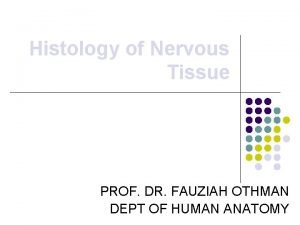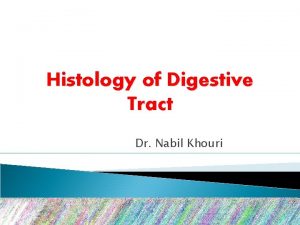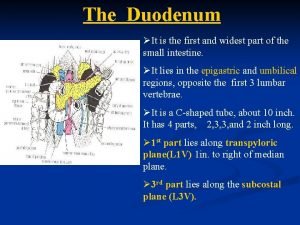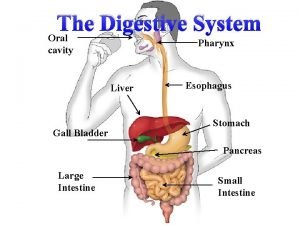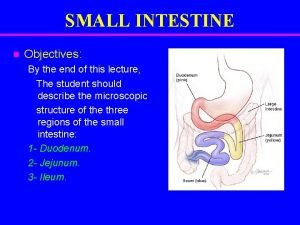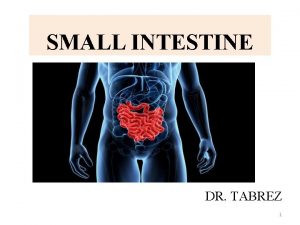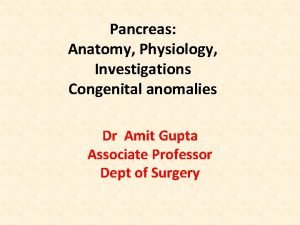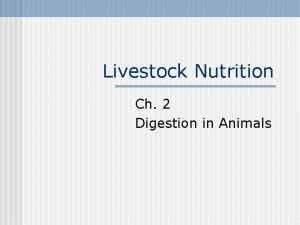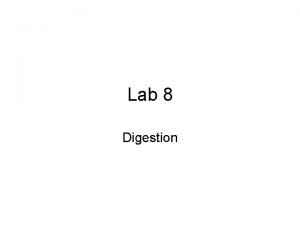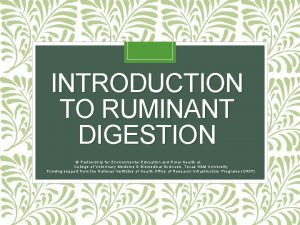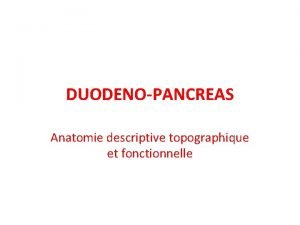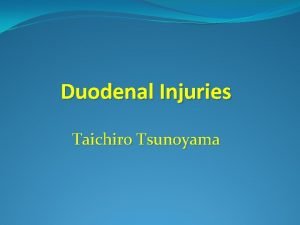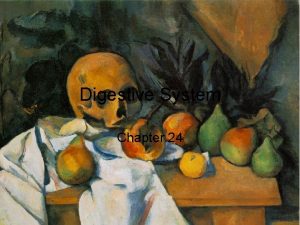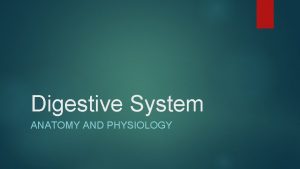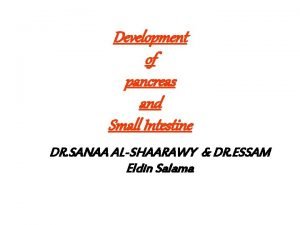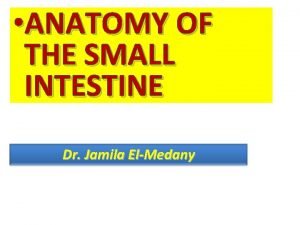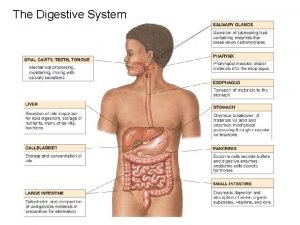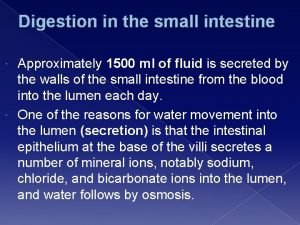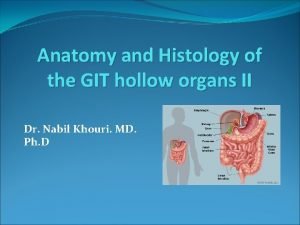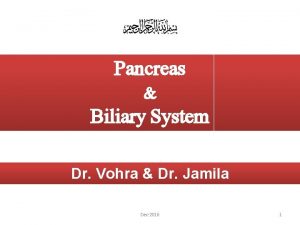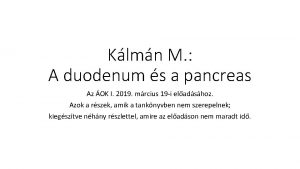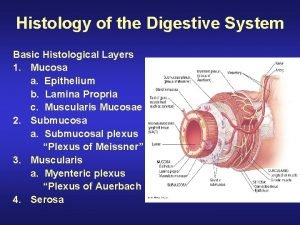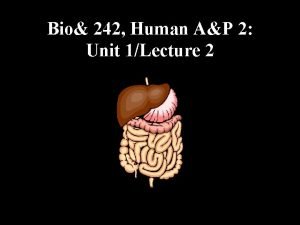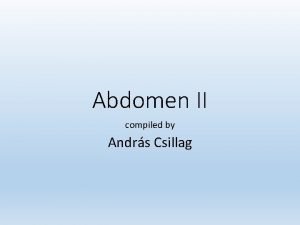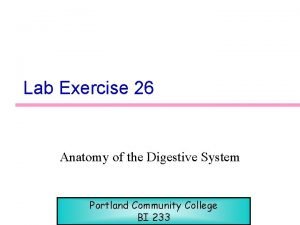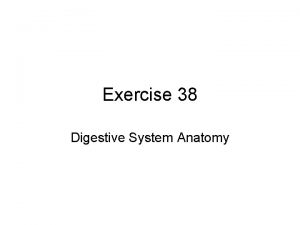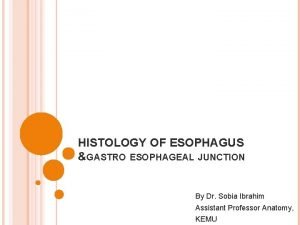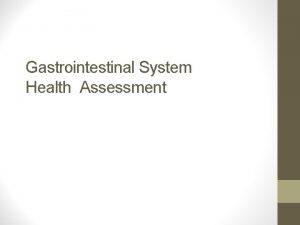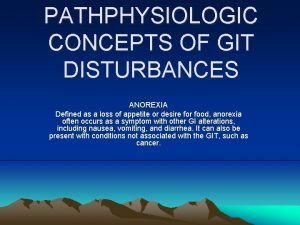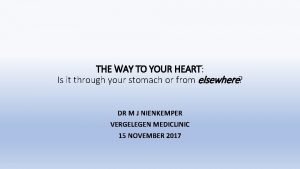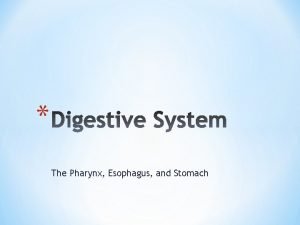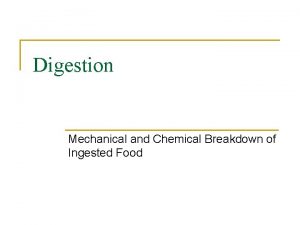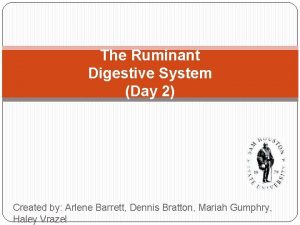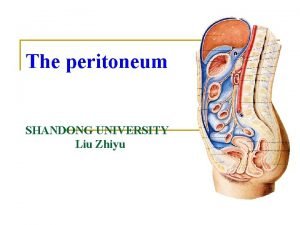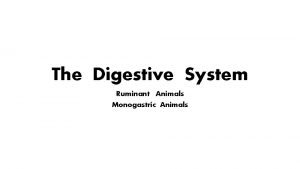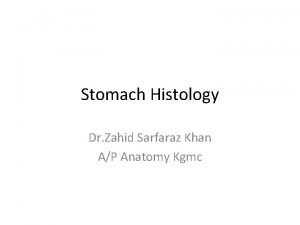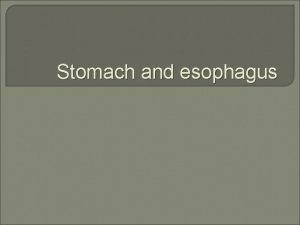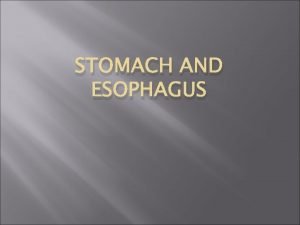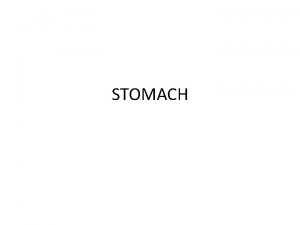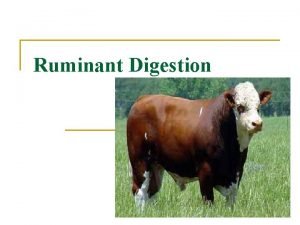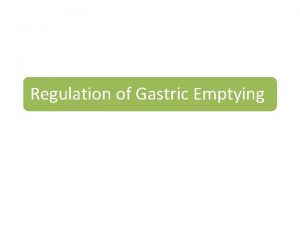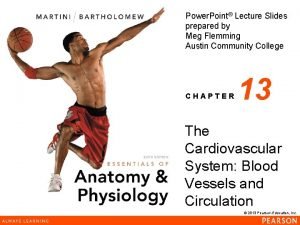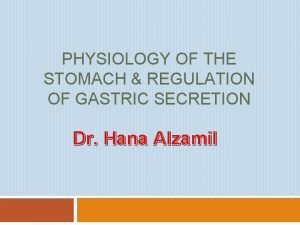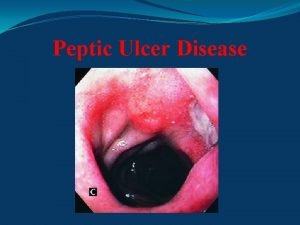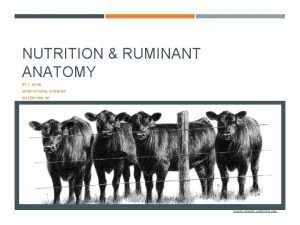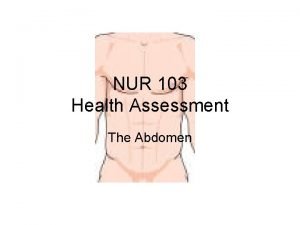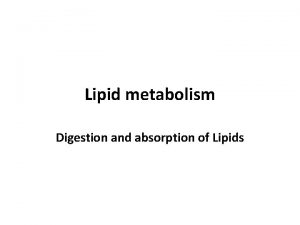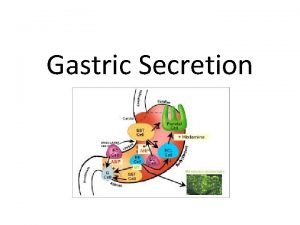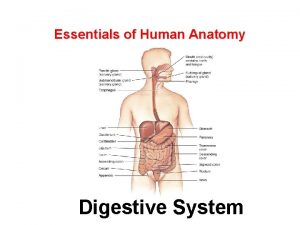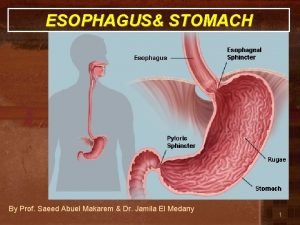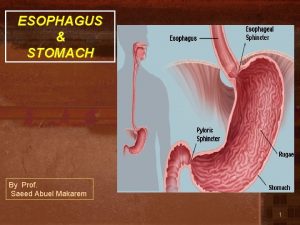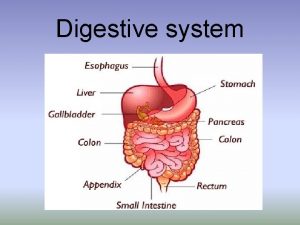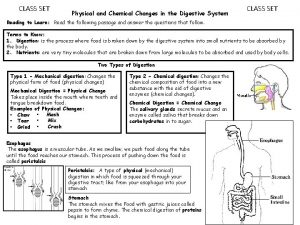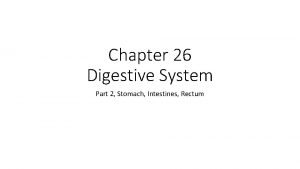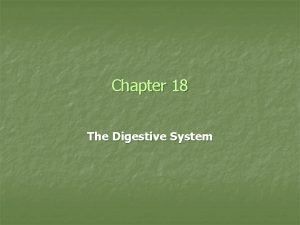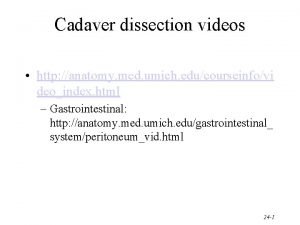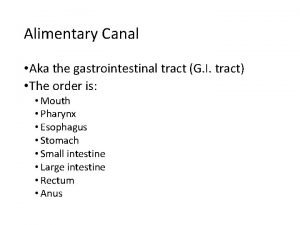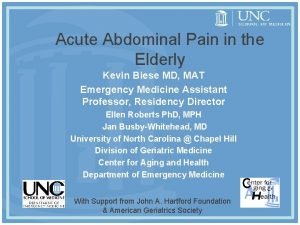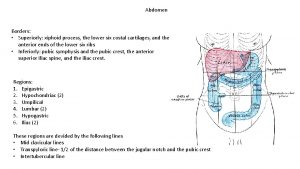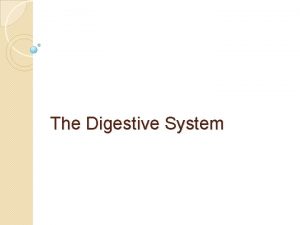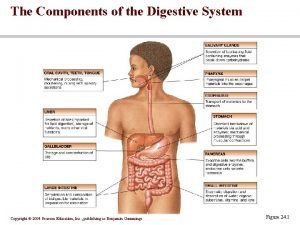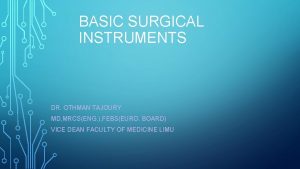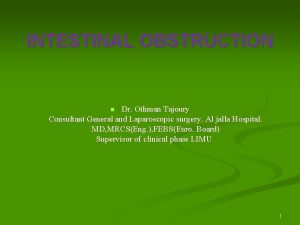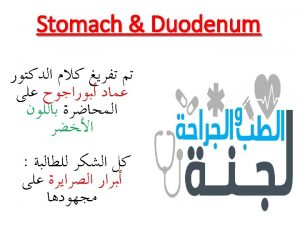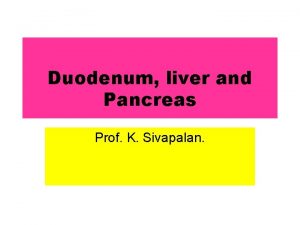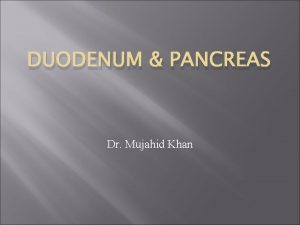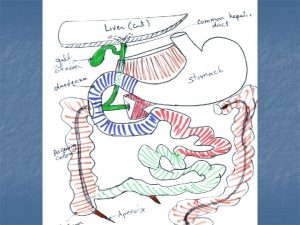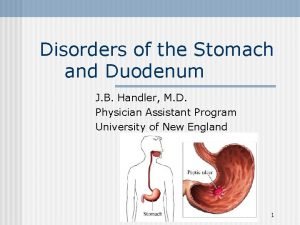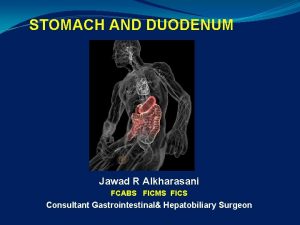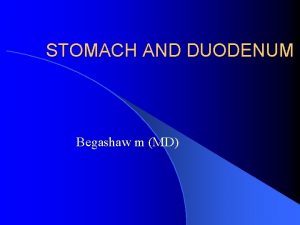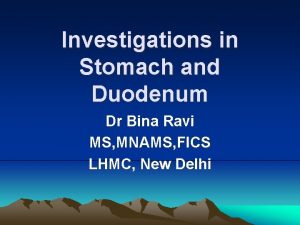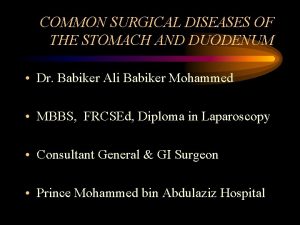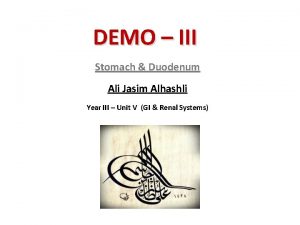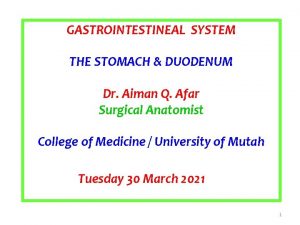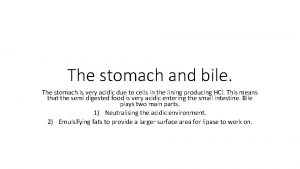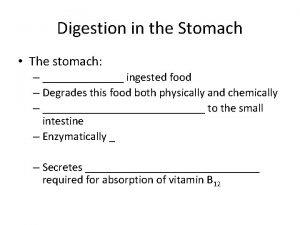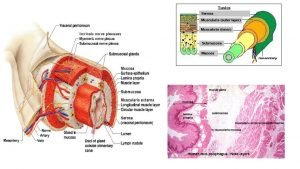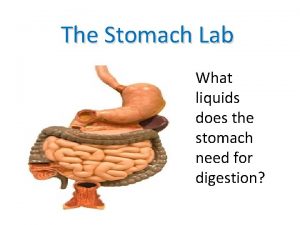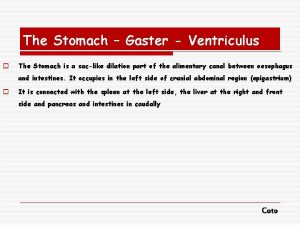Stomach and Duodenum Dr Othman Tajoury MD MRCSEng
















































































- Slides: 80

Stomach and Duodenum Dr. Othman Tajoury MD, MRCS(Eng. ), FEBS(Euro. Board) Supervisor of clinical phase LIMU

Learning Objectives • To understand the anatomy and pathophysiology of the • • stomach in relation to disease To be able to decide the appropriate techniques in the investigation and treat peptic ulcer disease and its complications To understand the critical importance of gastritis and Helicobacter pylori in upper gastrointestinal disease To be able to recognise the presentation of gastric cancer To know about the causes of duodenal obstruction and the presentation of duodenal tumours

Anatomy



Cell Types • Parietal: • Location: Body • Function: secrete acid and intrinsic factor (production of hydrogen ions to form hydrochloric acid) • Chief: • Location: Body • Function: produce pepsinogen I pepsin & digestive protease • Goblet: • Location: Body, Antrum • Function: mucus production

Cell Types • Entero. Chromaffin-Like (ECL): • Location: Body • Function: Histamine production • G cells: • Location: Antrum • Function: Gastrin production • D cells: • Location: Body, Antrum • Function: produce Somatostatin • Endocrine cells in the duodenum produce cholecystokinin and secretin.


Benign Gastric Disease(s) 1 - Gastritis 2 - Mallory-Weiss Syndrome 3 - Gastric Polyps 4 - Bezoars 5 - Gastric (peptic) Ulcer Disease

1 - Gastritis (acute or stress) • Widespread inflammation of the mucosa. • Causes: H. pylori, NSAIDS, physiologic stress.

Types of gastritis Type A gastritis: autoimmune, antibodies to the parietal cells. Type B gastritis: Helicobacter-associated gastritis. Reflux gastritis: common after gastric surgery Erosive gastritis: NSAIDs and alcohol are common causes. Stress gastritis: B/O reduction in the blood supply to superficial mucosa of the stomach. ▰ Ménétrier’s disease: gross hypertrophy of the gastric mucosal folds, premalignant. ▰ Lymphocytic gastritis: rare ▰ ▰ ▰

Gastritis Ø S&S: • Nausea, emesis, hematemesis, melena, hematochezia, etc. • Treatment: Ø Prevention, removal of offending agent. Ø Gastric decompression and support. ØAcid suppression (PPI), Ø Gastrectomy in severe cases

2 - Mallory-Weiss Syndrome

3 - Gastric Polyps • There are two types: a- Hyperplastic b- Adenomatous A- Hyperplastic polyps: • More common • Usually benign B- Adenomatous: • Precancerous

Gastric Polyps • Adenomatous polyps: • Greater risk of malignancy 40% (Precancerous) • < 0. 5 cm in diameter = very low risk. • > 1. 5 cm in diameter = very high risk. • Once a polyp is diagnosed, should be removed, 2. 5% recurrence rate

Peutz-Jegher’s Syndrome Autosomal dominant genetic disorder characterized by the development of benign hamartomatous polyps in the gastrointestinal tract and hyper pigmented macules on the lips and oral mucosa

4 - Bezoars • Phytobezoars = indigestible plant material (e. g. , cellulose) • Trichobezoars = an extreme form of hairball.

5 - Gastric Ulcers

Pathogenesis of ulcer • Increase acid production ▰ Lack of protection of the mucosa • 85%-95% of PU pts are colonized with H. pylori.

Helicobacter pylori (H. pylori) Serological tests ; 1 - H. pylori Ig. G antibodies (sensitivity and specificity 80% to 95% ) 2 - Breath test; the patient is given either 13 C- or 14 Clabeled urea to drink. H. pylori metabolizes the urea rapidly, and the labeled carbon is absorbed. then measured as CO 2 in the patient’s expired breath to determine whether H. pylori is present (sensitivity and specificity 94% to 98%)

3 - Upper esophagogastroduodenal endoscopy; biopsy is obtained and the diagnosis of H. pylori can be made by several methods: • The biopsy urease test; it provides rapid testing at the time of biopsy. • Histologic identification of organisms - considered the gold standard of diagnostic tests. • Culture of biopsy specimens for H. pylori, when antimicrobial susceptibility testing is desired. • Treatment: Triple therapy; amoxicillin, tetracycline (not to be used for children <12 yrs. ), metronidazole, or clarithromycin, plus proton pump inhibitor.

Gastric ulcers

Type I -Occur at the incisura. -Not associated with hyperacidity -Associated with Blood group “A”

Type II • A combination of 2 ulcers, one in the stomach, the other in the duodenum. • Usually occur in hypersecretory states. • Associated with Blood group“O”.

Type III • Located pre-pyloric. • Associated with hypersecretion. • Type “O” blood association. • Typically 2 -3 cm from pylorus, can be multi.

Type IV • Occur high on lesser curve near the GE junction. • Not associated with hypersecretion. • Usually result from defective mucosal defense.

Type V ▰ Medication-induced (NSAID/ acetylsalicylic acid), anywhere in stomach.

Complications of gastric ulcer 1. Bleeding; (penetration) 2. Perforation 3. Malignancy

Treatment of gastric ulcer Ø Ø ▰ ▰ Medical - Prevention, triple therapy, ppi. Surgical - in few cases Primary goals ; Excision of the ulcer and Reduction of acid/pepsin output Secondary goals ; Minimize bile reflux and gastric stasis

Bleeding gastric ulcer : operative procedures ▰ ▰ Endoscopic management with biobsy Simple oversewing with biopsy Gastric resection including ulcer (Gastrectomy) Excision of ulcer with TV and drainage without TV and drainage?

Perforated gastric ulcer : operative procedures ▰ Biopsy and simple closure ▰ Gastric resection

Malignant Gastric Disease 1 • Adenocarcinoma 2 • Lymphoma (MALToma) mucosa-associated lymphoid tissue 3 • Gastrointestinal Stromal Tumor (GIST)

1 -Gastric Adenocarcinoma

Gastric Adenocarcinoma • Adenocarcinoma accounts for 95% of all gastric cancers. • US and Europe = low risk areas • Asia (Japan/China), Russia, Chile = high risk areas.

Risk Factors • H. pylori infection. • Pernicious anemia. • Achlorhydria. • Chronic gastritis. • H/o caustic injury (corrosive ingestion) • Adenomatous polyps.

Ca stomach Classification • 4 Macroscopic types: Cauliflower, Ulcerative, Infiltrating, Colloid. § 3 Microscopic: Adenocarcinoma 95%, SCC 4%. Anaplastic 1% • DIO classification: - Diffuse - Intestinal - Otherwise

Diffuse ▰ On top of atrophic gastritis. • undifferentiated with classic signet-ring cells. • Patients are usually younger. • Associated with ABO blood group “A”. • Spreads via lymphatics and local extension.

Intestinal ▰ On top of intestinal metaplasia& Biliary gastritis • Well differentiated with glandular elements. • More common form in high incidence areas. • Patients are usually older male. • Hematogenous spread.

Gastric Adenocarcinoma. Investigations : OGD , CT , EUS , PET , Laparoscopy. . Treatment : Depend on site of tumor (Total , distal or proximal Gastrectomy + LN dis section)

2 -Gastric Lymphoma

Gastric Lymphoma • Stomach is the primary site for 2/3 of all GI lymphomas. • Predominately non-Hodgkin’s variant. • Symptoms are similar to Adeno-ca. • Dx: via biopsy (endoscopic vs. open). • If Dx is made prior to surgery, do lymphoma work-up. • Treatment: chemotherapy vs. surgery.

3 -Gastrointestinal stromal tumors GIST

GIST • Formerly called leiomyomas or leiomyosarcomas. • Stomach is the most common site. • Can be “benign” or “malignant”. • Malignant - direct invasion, mitotic • Work-up: CT , EUSS, etc

Treatment: - Surgical Resection w/ margins. - Gleevec : - Gleevec (imatinib mesylate) is a type of drug called a tyrosine kinase inhibitor (TKI). - Targeted drug therapy is different from traditional chemotherapy in that it is very selective

Duodenum • 4 parts • Produces many enzymes • D 2: posterolateral insertion of ampulla. • Becomes jejunum at the angle of Treitz

Benign Duodenal Disease • Duodenal Ulcer Disease(Uncomplicated or Complicated) • Duodenal Polyps

Uncomplicated Ulcer • In contrast to gastric ulcers, duodenal ulcers rarely harbor malignancy.

Uncomplicated Ulcer Important risk factors: • H. pylori , NSAIDs , tobacco. • Treatment : mainly medical; ( triple therapy) instead of surgical.

Presentation • Burning, gnawing pain in the epigastrium. • it may radiate to the back. • Exacerbated by fasting. • Relief gained from meds and eating.

Evaluation/Testing • Non-invasive H. pylori testing. (Serum antibodies, breath urease, fecal antigen). • If (+) test = H. pylori treatment (triple therapy). • If primary treatment fails then do upper endoscopy. • OGD allows for visualization, biopsy, evaluation for alternate diagnosis.

Treatment • Non-operative • Remove all ulcerogenic agents. • Start acid suppression (PPI) • Eradicate H. pylori.

Treatment • H. pylori therapy: First Line: • Amoxicillin and Clarithromycin or Clarithromycin and Flagyl (+) PPI • Treat for 7 – 14 days. • Recheck for H. pylori after treatment. • Continue acid suppression until ulcer is healed.

Complicated Ulcer • 4 major manifestations: • Perforation • Bleeding (penetration) • Gastric outlet obstruction • Intractable

Treatment: Perforation • Typical presentation of acute abdomen. Ø Resuscitation. Ø Operation: 1. Graham patch (omentoplasty). 2. +/- (Antrectomy with drainage) + (vagotomy).



Bleeding Treatment: • Resuscitation. • Upper endoscopy with local treatment. • High-risk stigmata : active bleeding, visible vessel, fresh clot. • Angiography with embolization. • Surgical intervention. Suturing bleeding vessel + (TV) Truncal vagotomy and pyloroplasty PP or HSV

Bleeding Indications for operative intervention: 1. Massive hemorrhage leading to shock 2. Prolonged blood loss requiring continuing transfusion 3. Recurrent bleeding during medical therapy or after endoscopic therapy 4. Recurrent bleeding requiring hospitalization 5. Rare blood groups

Outlet obstruction • NPO, NG, Rehydration, Correct electrolytes. • Some resolve (swelling). ▰ Some Endoscopic dilatation • Some Surgery: -Remove obstruction (Antrectomy with drainage) -Bypass obstruction (Gastroenterostomy).


Intractability ▰ Ulceration persists at 3 months despite active drug therapy ▰ Ulcers recur within 1 year of initial healing despite maintenance therapy ▰ The ulcer disease is characterized by cycles of prolonged activity with brief or absent remissions

Intractability • Medical failure – look for other causes like, ZE syndrome, non-compliance, etc. • Surgery - HSV - TV + Antrectomy - TV + PP






Drainage procedures : pyloroplasty ▰ ▰ ▰ Heineke-Mikulicz Finney Jaboulay

Heineke-Mikulicz pyloroplasty



Duodenal polyps Typically arise as part of a familial disorder. • FAP. - Autosomal dominant - High malignant potential • Peutz-Jegher’s syndrome.

Malignant Duodenal Disease • Adenocarcinoma • Lymphoma ▰ Zolliger-Ellison (ZE) Syndrome (gastrinoma)

Adenocarcinoma • Duodenum is the most common site for small bowel adenocarcinoma. • ~ 2/3 are peri-ampullary (D 2). • Only treatment is resection (if possible). • Double bypass if unresectable. • (+) LN’s = < 15%, 5 year survival.

Adenocarcinoma

Zollinger–Ellison syndrome • Rare disease. • Disease is a direct result of gastrinoma. • 2/3 of gastrinomas are in the “triangle” • Can be sporadic or hereditary. • Strong assoc. with MEN-I (3 p’s) Pituitary, Parathyroid, Pancreas. • Treatment: 1 - PPI 2 -resection (if possible).

Gastrinoma - Tumor in the pancreas or duodenum that secretes excess of gastrin leading to ulceration in the duodenum, stomach and the small intestine. - There is hypersecretion of HCl. - Gastrinoma triangle; region in between three points: - Superior- Body of Gallbladder. - Inferior-junction of the second and third portion of duodenum. - Medial- junction of the neck and body of the pancreas.

Lymphoma • Rare, most small bowel lymphomas are ileal. • Similar presentation to adenocarcinoma. • Diagnose the same as gastric lymphoma. • Resection if resectable. • Chemotherapy and radiation.

Lymphoma

Thank you
 Othman najmi
Othman najmi Othman line 2
Othman line 2 Othman line 2
Othman line 2 Neuron histology
Neuron histology Breakdown due to treeing and tracking
Breakdown due to treeing and tracking Difference between duodenum and jejunum
Difference between duodenum and jejunum 3 parts of duodenum
3 parts of duodenum Pharynx in digestive system
Pharynx in digestive system Right colic flexure
Right colic flexure Brunner
Brunner Four parts of duodenum
Four parts of duodenum Small intestine
Small intestine Eutonic stomach
Eutonic stomach Ulcer niche
Ulcer niche Relations of bile duct
Relations of bile duct Duodenum cow
Duodenum cow Parotid
Parotid Ruminant digestive system
Ruminant digestive system Bloc duodéno pancréatique
Bloc duodéno pancréatique Duodenal diverticulization
Duodenal diverticulization What does bile digest in a frog
What does bile digest in a frog Pyloric valve
Pyloric valve Function of digestive system
Function of digestive system The organ located in the duodenal loop in the mammal is the
The organ located in the duodenal loop in the mammal is the Duodenum development
Duodenum development Fourth portion of the duodenum
Fourth portion of the duodenum Jejunum and ileum
Jejunum and ileum Digestion in the duodenum
Digestion in the duodenum Histologi duodenum
Histologi duodenum Duodenum arterial supply
Duodenum arterial supply Truncus gastropancreaticocolicus
Truncus gastropancreaticocolicus Histology digestive system
Histology digestive system Digestive system histology
Digestive system histology Synaptic integration
Synaptic integration Duodenum cell
Duodenum cell Arcus riolani
Arcus riolani Duodenum
Duodenum Overview of the digestive system
Overview of the digestive system Kode icd 10 ulkus duodenum
Kode icd 10 ulkus duodenum Esophagus stomach junction histology
Esophagus stomach junction histology Abdominal quadrants with organs
Abdominal quadrants with organs Anatomy and physiology of stomach ppt
Anatomy and physiology of stomach ppt Excessive acid production
Excessive acid production Pls take care of yourself
Pls take care of yourself Parts of the stomach
Parts of the stomach Stomach greens and liquefies food
Stomach greens and liquefies food Define ruminant digestive system
Define ruminant digestive system Hepatorenal recess
Hepatorenal recess Monogastric vs ruminant
Monogastric vs ruminant Mouth esophagus stomach intestines
Mouth esophagus stomach intestines Pylorus histology
Pylorus histology Mammillated areas of stomach
Mammillated areas of stomach Orifices of stomach
Orifices of stomach Stomach diagram
Stomach diagram Gastric antrum
Gastric antrum Gastric arteries
Gastric arteries Ruminant stomach
Ruminant stomach What is pyloric pump
What is pyloric pump Major systemic arteries labeled
Major systemic arteries labeled Parietal cell of stomach secrete
Parietal cell of stomach secrete Stomach ulcer diet menu
Stomach ulcer diet menu Peptic ulcer anatomy
Peptic ulcer anatomy Macrominerals
Macrominerals Light palpation vs deep palpation
Light palpation vs deep palpation Why did jack want samneric to get him a coconut?
Why did jack want samneric to get him a coconut? Digestion of lipids
Digestion of lipids Composition of the gastric juice
Composition of the gastric juice Cardiac orifice of stomach
Cardiac orifice of stomach Parts of abdomen
Parts of abdomen Stomach location
Stomach location 9 parts of stomach
9 parts of stomach Is the stomach a physical or chemical change
Is the stomach a physical or chemical change Pancreas awkward yeti
Pancreas awkward yeti Pancreatic juice
Pancreatic juice Esophagus cadaver
Esophagus cadaver Composition of stomach
Composition of stomach Stomach virus
Stomach virus Medial line
Medial line Mesenteric sinus
Mesenteric sinus What organ
What organ Muscularis mucosae
Muscularis mucosae



